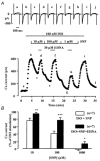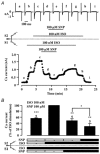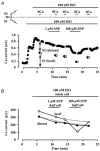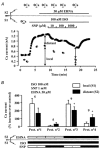Local response of L-type Ca(2+) current to nitric oxide in frog ventricular myocytes
- PMID: 11432996
- PMCID: PMC2278687
- DOI: 10.1111/j.1469-7793.2001.00109.x
Local response of L-type Ca(2+) current to nitric oxide in frog ventricular myocytes
Abstract
1. The regulation of L-type Ca(2+) current (I(Ca)) by the two nitric oxide (NO) donors sodium nitroprusside (SNP, 1 microM to 1 mM) and (+/-)-S-nitroso-N-acetylpenicillamine (SNAP, 3 or 10 microM) was investigated in frog ventricular myocytes using double voltage clamp and double-barrelled microperfusion techniques. 2. SNP and SNAP depressed the isoprenaline (ISO, 10-100 nM)- or forskolin (FSK, 1 microM)-mediated stimulation of I(Ca) via cGMP activation of the cGMP-stimulated phosphodiesterase (PDE2). Complete inhibition of the ISO (100 nM) response was observed at 1 mM SNP. 3. When SNP was applied locally, i.e. to one-half of the cell, and ISO to the whole cell, the response of I(Ca) to ISO was strongly antagonized in the cell half exposed to SNP (up to 100 % inhibition at 1 mM SNP) but a relatively small depression was observed in the other half of the cell (only 20 % inhibition at 1 mM SNP). 4. The NO scavenger 2-(4-carboxyphenyl)-4,4,5,5-tetramethylimidazoline-1-oxyl 3-oxide (carboxy-PTIO, 1 mM) reversed the local effect of SNAP (3 microM) on FSK-stimulated I(Ca) when applied to the same side as the NO donor, but had no effect when applied to the other side of the cell. 5. A local application of erythro-9-(2-hydroxy-3-nonyl)adenine (EHNA, 30 microM), a selective inhibitor of PDE2, fully reversed the local effect of SNP (100 microM) or SNAP (10 microM) on I(Ca) but had no effect on the distant response. 6. When EHNA was applied on the distant side, with SNP (1 mM) and ISO (100 nM) applied locally, the distant effect of SNP was fully reversed. 7. Our results demonstrate that in frog ventricular myocytes stimulation of guanylyl cyclase by NO leads to a strong local depletion of cAMP near the L-type Ca(2+) channels due to activation of PDE2, but only to a modest reduction of cAMP in the rest of the cell. This may be explained by the existence of a tight microdomain between L-type Ca(2+) channels and PDE2.
Figures








Similar articles
-
Role of cyclic nucleotide phosphodiesterase isoforms in cAMP compartmentation following beta2-adrenergic stimulation of ICa,L in frog ventricular myocytes.J Physiol. 2003 Aug 15;551(Pt 1):239-52. doi: 10.1113/jphysiol.2003.045211. Epub 2003 Jun 18. J Physiol. 2003. PMID: 12815180 Free PMC article.
-
NO donors potentiate the beta-adrenergic stimulation of I(Ca,L) and the muscarinic activation of I(K,ACh) in rat cardiac myocytes.J Physiol. 2002 Apr 15;540(Pt 2):411-24. doi: 10.1113/jphysiol.2001.012929. J Physiol. 2002. PMID: 11956332 Free PMC article.
-
NO-cGMP pathway increases the hyperpolarisation-activated current, I(f), and heart rate during adrenergic stimulation.Cardiovasc Res. 2001 Dec;52(3):446-53. doi: 10.1016/s0008-6363(01)00425-4. Cardiovasc Res. 2001. PMID: 11738061
-
Cyclic GMP regulation of the L-type Ca(2+) channel current in human atrial myocytes.J Physiol. 2001 Jun 1;533(Pt 2):329-40. doi: 10.1111/j.1469-7793.2001.0329a.x. J Physiol. 2001. PMID: 11389195 Free PMC article.
-
Species- and tissue-dependent effects of NO and cyclic GMP on cardiac ion channels.Comp Biochem Physiol A Mol Integr Physiol. 2005 Oct;142(2):136-43. doi: 10.1016/j.cbpb.2005.04.012. Epub 2005 May 31. Comp Biochem Physiol A Mol Integr Physiol. 2005. PMID: 15927494 Review.
Cited by
-
Nitric oxide signalling by selective beta(2)-adrenoceptor stimulation prevents ACh-induced inhibition of beta(2)-stimulated Ca(2+) current in cat atrial myocytes.J Physiol. 2002 Aug 1;542(Pt 3):711-23. doi: 10.1113/jphysiol.2002.023341. J Physiol. 2002. PMID: 12154173 Free PMC article.
-
Phenylephrine acts via IP3-dependent intracellular NO release to stimulate L-type Ca2+ current in cat atrial myocytes.J Physiol. 2005 Aug 15;567(Pt 1):143-57. doi: 10.1113/jphysiol.2005.090035. Epub 2005 Jun 9. J Physiol. 2005. PMID: 15946966 Free PMC article.
-
A common NOS1AP genetic polymorphism is associated with increased cardiovascular mortality in users of dihydropyridine calcium channel blockers.Br J Clin Pharmacol. 2009 Jan;67(1):61-7. doi: 10.1111/j.1365-2125.2008.03325.x. Epub 2008 Nov 17. Br J Clin Pharmacol. 2009. PMID: 19076153 Free PMC article.
-
Cyclic guanosine monophosphate compartmentation in rat cardiac myocytes.Circulation. 2006 May 9;113(18):2221-8. doi: 10.1161/CIRCULATIONAHA.105.599241. Epub 2006 May 1. Circulation. 2006. PMID: 16651469 Free PMC article.
-
cGMP Signaling in the Cardiovascular System-The Role of Compartmentation and Its Live Cell Imaging.Int J Mol Sci. 2018 Mar 10;19(3):801. doi: 10.3390/ijms19030801. Int J Mol Sci. 2018. PMID: 29534460 Free PMC article. Review.
References
-
- Akaike T, Yoshida M, Miyamoto Y, Sato K, Kohno M, Sasamoto K, Miyazaki K, Ueda S, Maeda H. Antagonistic action of imidazolineoxyl N-oxides against endothelium-derived relaxing factor/NO through a radical reaction. Biochemistry. 1993;32:827–832. - PubMed
-
- Beavo JA, Reifsnyder DH. Primary sequence of cyclic nucleotide phosphodiesterase isozymes and the design of selective inhibitors. Trends in Pharmacological Sciences. 1990;11:150–155. - PubMed
-
- Brodde OE, Michel MC. Adrenergic and muscarinic receptors in the human heart. Pharmacological Reviews. 1999;51:651–689. - PubMed
Publication types
MeSH terms
Substances
LinkOut - more resources
Full Text Sources
Miscellaneous

